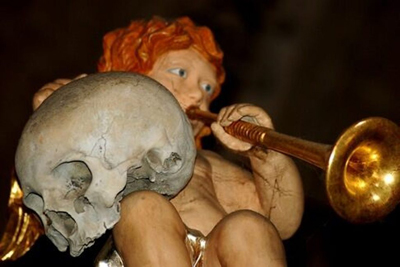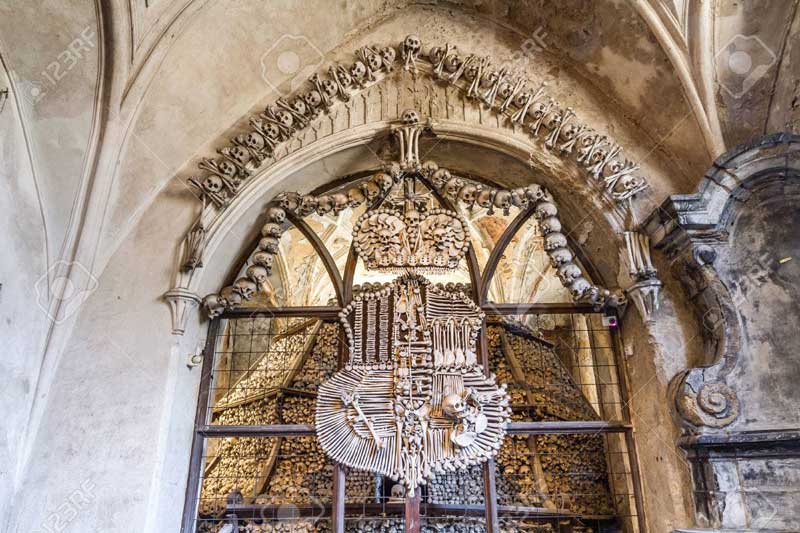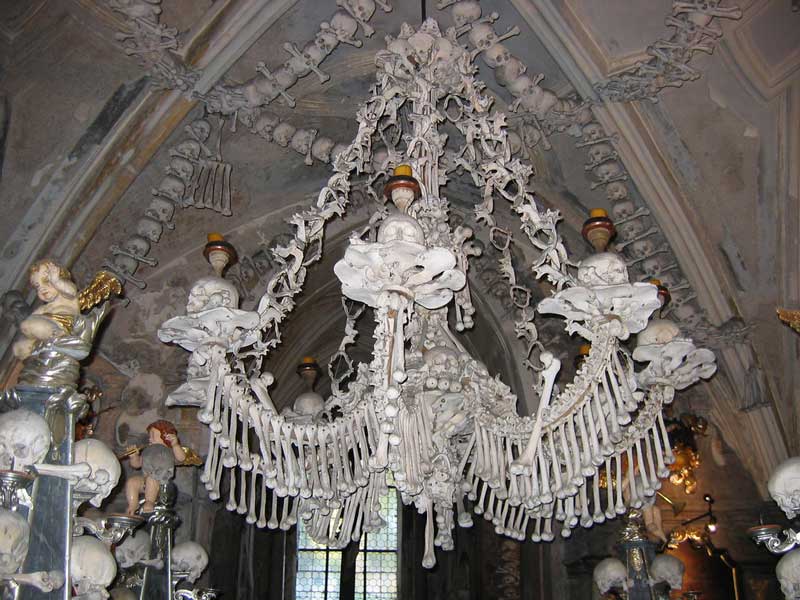
The Sedlec Ossuary, an unimpressive and small Roman Catholic chapel located beneath the Cemetery Church of All Saints in Sedlec, a suburb of Kutna Hora in the Czech Republic, is popularly known as the Bone church and displays an unusual kind of macabre art. It is ghastly decorated with thousands of human bones, bleached, and ornately carved to artistically cover everything in sight.
Apart from the pyramids of bones in every possible corner, and a splendid bone chandelier created with almost every bone in a human body, Sedlec Ossuary exhibits two large bone chalices, four candelabras, two bone monstrances, or vessels used during devotional ceremonies, a family crest, and skull candle holders. Even, festively looping chains of bone are hung like crepe paper chains displayed at birthday parties. Estimated to contain the skeletons of between 40,000 and 70,000 people, the ossuary is one of the most visited tourist attractions of the Czech Republic, attracting around two hundred-thousand visitors every year.

The history of the Sedlec Ossuary can be traced back to 1278 when Abbot Henry, head of the Abbot of the Sedlec Monastery, made a pilgrimage to Jerusalem and brought back a handful of soil from Golgotha, the site of Jesus’ crucifixion, to sprinkle it over the abbey cemetery as an act of consecration.
With the spread of the news of Abbot’s action, the Sedlec cemetery became a highly desirable burial site throughout Bohemia and the adjacent countries. The pressure on the cemetery abruptly increased in the mid 14th century, during the Black Death, when plague epidemics ravaged Europe, and 30,000 victims were buried in the abbey cemetery. Apart from the local burials, the Hussite Wars, also known as Bohemian Wars that lasted from 1419 to around 1434, added no less than another 10,000 bodies.

As it became evident that there was simply not enough room for everyone to rest in peace in the cemetery, a Gothic church was built in the centre of the burial ground around 1400, with a vaulted upper level and a lower chapel to be used as an ossuary, where remnants of the mass graves were moved to make room for the new burials.
The pyramids of bones in the corners of the ossuary were allegedly arranged in the early 16th century by a half-blind monk of the order who was entrusted with the task of exhuming the skeletons and stacking the bones. It is said that he regained his sight after he completed arranging the skulls, femurs, and other bones to his liking. It may sound strange, but the decorations in the Bone Church were created from those heaps of bones.

The pyramids of bones remained untouched for around three centuries until 1870 when František Rint, a Czech woodcarver was hired by the powerful and noble Schwarzenberg family to create something worthy from the staggering piles of bones. Rint in his turn, disinfected the bones, bleached them with chlorinated lime to give them a uniform appearance, and finally rendered his best and decorated the holy place with his untiring artistic efforts, and signed his name on the wall near the entrance to the chapel, executed with the help of unused hand and arm bones.

Although it may seem to be macabre to many, Rint made chains of skulls to stretch across the entryways, while chalices and crosses were constructed from the hips and femurs. The family crest of the Schwarzenberg, made of bones and detailed with the family coat of arms, and a raven plucking the eye out of the head of a Turk, is fastened with rails along a wall. However, perhaps the most famous feature of the Sedlec Ossuary is the eight feet chandelier, said to incorporate every single bone in a human body, at least once. Glowing candles from the white skulls spreads an eerie sensation in the hearts of the visitors.

To commemorate the centenary of Rint’s contribution, the Czech surrealist filmmaker Jan Svankmajer was commissioned to document the Sedlec Ossuary. However, the black and white short film was initially banned by the Czech Communist authorities for alleged subversion, contrary to the communistic ideals. Later, the original audio-track of the film containing the narration was replaced by a piece of piano-music and the recitation of a poem, added to the film with the 10-minute long frantic cuts.